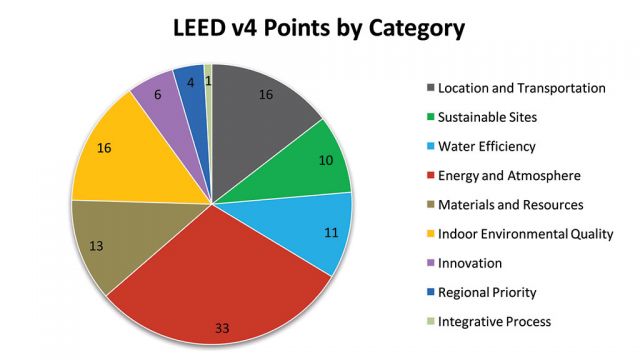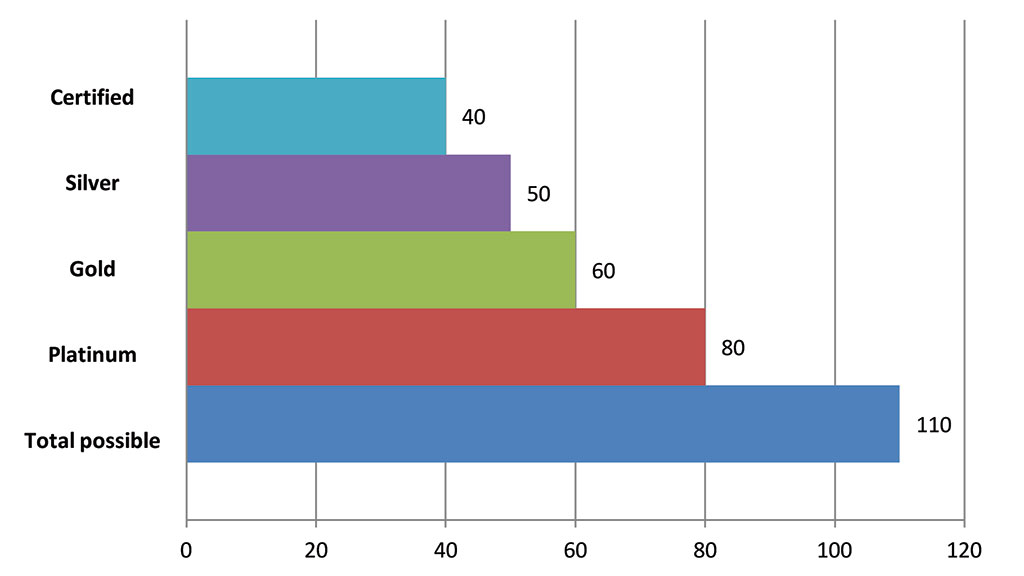Figure 1 — LEED v4 credit categories.
November 16, 2016 7:00 AM CST
In late 2013, the USGBC released an updated version of LEED, known as LEED v4, which revised many of the credits in the rating system, especially those related to building materials and products. At present, designers can use either the older rating system, LEED 2009, or the LEED v4 system. Beginning on Nov. 1, 2016, only the LEED v4 system will be available for use. LEED v4 contains the same general categories as LEED 2009, but the Materials & Resources category is changed significantly to focus on building product transparency and disclosures.
One of the other new focuses in LEED v4 is on integrated design process. The goal of this approach is to achieve “synergies across disciplines and building systems.” For this and other reasons, it is advisable that contractors and subcontractors familiarize themselves with the overall structure of the LEED rating system so that they can be knowledgeable partners at the table early in the design process. General information and a copy of the LEED rating system can be found at www.usgbc.org/leed. USGBC also maintains a credit library with specific requirements for each credit in all versions of the rating system (www.usgbc.org/credits).
There are three general areas that typically have a direct impact on the mason subcontractor. These are material selection, documentation and construction/installation.
Masonry-related products that may contain recycled content include concrete masonry units, clay brick, grout and, less often, mortar. In addition, many masonry accessories may incorporate recycled content; these include masonry anchors, cavity drainage materials and some flashing materials.
Selecting products having an Environmental Product Disclosure (EPD) is one way to earn a point in LEED v4. As a result, many designers are specifying products that have published EPDs or at least published a Life Cycle Assessment (LCA). The pool of masonry products that have published LCAs or EPDs is limited, but growing.
Raw material ingredient reporting can also earn points in LEED v4, so specifiers are seeking products that have either (1) published product ingredient lists, (2) published a Health Product Declaration (HPD), or (3) published a Cradle to Cradle (C2C) certification. See the sidebar for more information on product disclosures.
One common credit relates to construction waste management. This credit requires documentation of construction waste diversion. Nearly all masonry materials are recyclable. This includes masonry units, strapping, pallets and other packaging, and metal accessories and reinforcement. LEED projects may use either commingled recycling or sort-on-site recycling. In either case, strict adherence to proper recycling is important to achieve the project LEED goals.
A permeable paving system is another area requiring careful attention. On a LEED project, permeable pavements may be used to reduce stormwater runoff and reduce the heat island effect. Proper installation is essential in achieving these LEED credits.
LEED™ Essentials for Mason Contractors
By Christine A. Subasic, P.E., Leed AP
The LEED™ Rating System
Most people in the construction industry are at least somewhat familiar with LEED™, the most widely used green building rating system in the U.S. For those who are not, LEED is a rating system designed to evaluate buildings in the areas of energy use, water use, materials use, indoor environment, the building site and location. LEED contains a total of 110 possible points distributed among 35 optional credits, as shown in Figure 1. The U.S. Green Building Council (USGBC) certifies buildings that meet enough of the LEED requirements according to the total number of points earned (see Figure 2).In late 2013, the USGBC released an updated version of LEED, known as LEED v4, which revised many of the credits in the rating system, especially those related to building materials and products. At present, designers can use either the older rating system, LEED 2009, or the LEED v4 system. Beginning on Nov. 1, 2016, only the LEED v4 system will be available for use. LEED v4 contains the same general categories as LEED 2009, but the Materials & Resources category is changed significantly to focus on building product transparency and disclosures.
One of the other new focuses in LEED v4 is on integrated design process. The goal of this approach is to achieve “synergies across disciplines and building systems.” For this and other reasons, it is advisable that contractors and subcontractors familiarize themselves with the overall structure of the LEED rating system so that they can be knowledgeable partners at the table early in the design process. General information and a copy of the LEED rating system can be found at www.usgbc.org/leed. USGBC also maintains a credit library with specific requirements for each credit in all versions of the rating system (www.usgbc.org/credits).
There are three general areas that typically have a direct impact on the mason subcontractor. These are material selection, documentation and construction/installation.
Material Selection
The materials selected on a LEED project have a direct impact on earning many of the LEED credits. The most common selection factors include recycled content, regional manufacture, salvaged materials, and product transparency disclosures. All can have an impact on availability and cost. Each is discussed in more detail below.Recycled Content
The credits for use of building products containing recycled content are among the most frequently achieved of all the LEED credits. In LEED 2009, points are based on the dollar value of recycled content in building products as compared to the total value of the materials on the project. In LEED v4, recycled content is only one part of a larger credit, and so the direct point contribution is reduced. Nevertheless, many designers consider recycled content when making their product selections.Masonry-related products that may contain recycled content include concrete masonry units, clay brick, grout and, less often, mortar. In addition, many masonry accessories may incorporate recycled content; these include masonry anchors, cavity drainage materials and some flashing materials.
Regional Manufacture
In the LEED rating system, designers may choose building products based on their location of manufacture. Actually, both the location of manufacture and the source of raw materials are important. Both must be within 500 miles of the project site under LEED 2009, and within 100 miles of the project site in the newer LEED v4. These distances are measured as the crow flies. Many masonry materials are regionally available.Salvaged Materials
Salvaged materials may also be specified more often on LEED projects. For masonry, these may include salvaged brick units or even sand set pavers.Product Transparency Disclosures
LEED v4 brought many changes to the Materials & Resources section, one of the primary changes being the introduction of several points associated with disclosing information about a product’s manufacture.Selecting products having an Environmental Product Disclosure (EPD) is one way to earn a point in LEED v4. As a result, many designers are specifying products that have published EPDs or at least published a Life Cycle Assessment (LCA). The pool of masonry products that have published LCAs or EPDs is limited, but growing.
Raw material ingredient reporting can also earn points in LEED v4, so specifiers are seeking products that have either (1) published product ingredient lists, (2) published a Health Product Declaration (HPD), or (3) published a Cradle to Cradle (C2C) certification. See the sidebar for more information on product disclosures.
Product Documentation
Product submittals on a LEED project are generally more onerous than on a non-LEED project. Documentation is required to confirm any LEED material credit being pursued. Product submittals should include all the customary information as well as information on the recycled content, location of manufacture, and other LEED-specific information. It is usually recommended to provide all general product information as well as all LEED-specific information in one submission. In addition, because the calculation for many of these credits is based on the total value of materials on the project, the cost of the building product, as delivered to the project, but not installed, must often be provided. In some cases, the project designers may provide a template for required information.Recycled Content
Recycled content of building products must be reported as a percent of the total weight of materials. Note that LEED distinguishes between post-consumer recycled content such as that obtained from recycled bottle glass, and pre-consumer recycled content such as fly ash. Pre-consumer recycled content and post-consumer recycled content must be listed separately.Regional Manufacture
The distance from the project site to the location of manufacture and the source of raw materials should also be reported. In most cases, it is sufficient to note whether the product has raw materials sourced and manufactured within 500 miles of the project site (if LEED 2009) or within 100 miles of the project site (if LEED v4). Note that the distance from the specific manufacturing location is required. If a product is manufactured in multiple locations, the one used to source the specific project must be used. All distances are measured as the crow flies.VOC Content
LEED projects pursuing indoor environmental quality often require selection of products containing no or low volatile organic compounds (VOC). In this case, product submittals must include test data showing compliance with the LEED requirements. Stone, ceramic, glass, concrete, and clay brick masonry materials are considered fully compliant without any VOC emissions testing if they do not include integral organic-based surface coatings, binders or sealants. In this case, confirmation of ingredients may be necessary.Product Disclosures
If a selected building product has an EPD, HPD or other form of product transparency disclosure, a copy of the declaration should be provided as part of the product data submittal.Construction
On a LEED project, it is especially important for the subcontractor to clearly understand the general contractor’s expectations for construction and installation. Many LEED credits are entirely dependent upon proper execution of the construction requirements. Seemingly minor mistakes can result in the loss of a LEED credit and can significantly impact the project.One common credit relates to construction waste management. This credit requires documentation of construction waste diversion. Nearly all masonry materials are recyclable. This includes masonry units, strapping, pallets and other packaging, and metal accessories and reinforcement. LEED projects may use either commingled recycling or sort-on-site recycling. In either case, strict adherence to proper recycling is important to achieve the project LEED goals.
A permeable paving system is another area requiring careful attention. On a LEED project, permeable pavements may be used to reduce stormwater runoff and reduce the heat island effect. Proper installation is essential in achieving these LEED credits.
Conclusion
LEED projects benefit from all parties having an understanding of the LEED rating system and in particular the LEED credits related to their specialty area. Check out the resources listed below for further information on the ways masonry can play a role on LEED projects. On a LEED project, a knowledgeable mason contractor can be an asset to the project by providing information on product availability and costs, supplying timely and complete product data submissions, and adhering to construction requirements.Resources on Masonry and LEED
- Masonry Is Sustainable, The Masonry Society, Longmont, Colo., http://www.masonrysociety.org/html/resources/Sustainability_Brochure/TMS_Sustainability_Brochure-2014-10-10.pdf.
- Subasic, C., LEED v4: New Categories and Credits Shake Up Ways of Contributing, SMART dynamics of masonry, Vol. 1, No. 4, 2014, http://www.dynamicsofmasonry.com/content/leed-v4.
Originally published in Masonry magazine.
About the Author
Christine Subasic, P.E., LEED AP, of C. Callista Subasic is a masonry expert. Earlier this year, she was chosen to represent The Masonry Society with the U.S. Green Building Council.
1 LEED Reference Guide for Building Design and Construction, U.S. Green Building Council, Washington, DC, 2013.




















